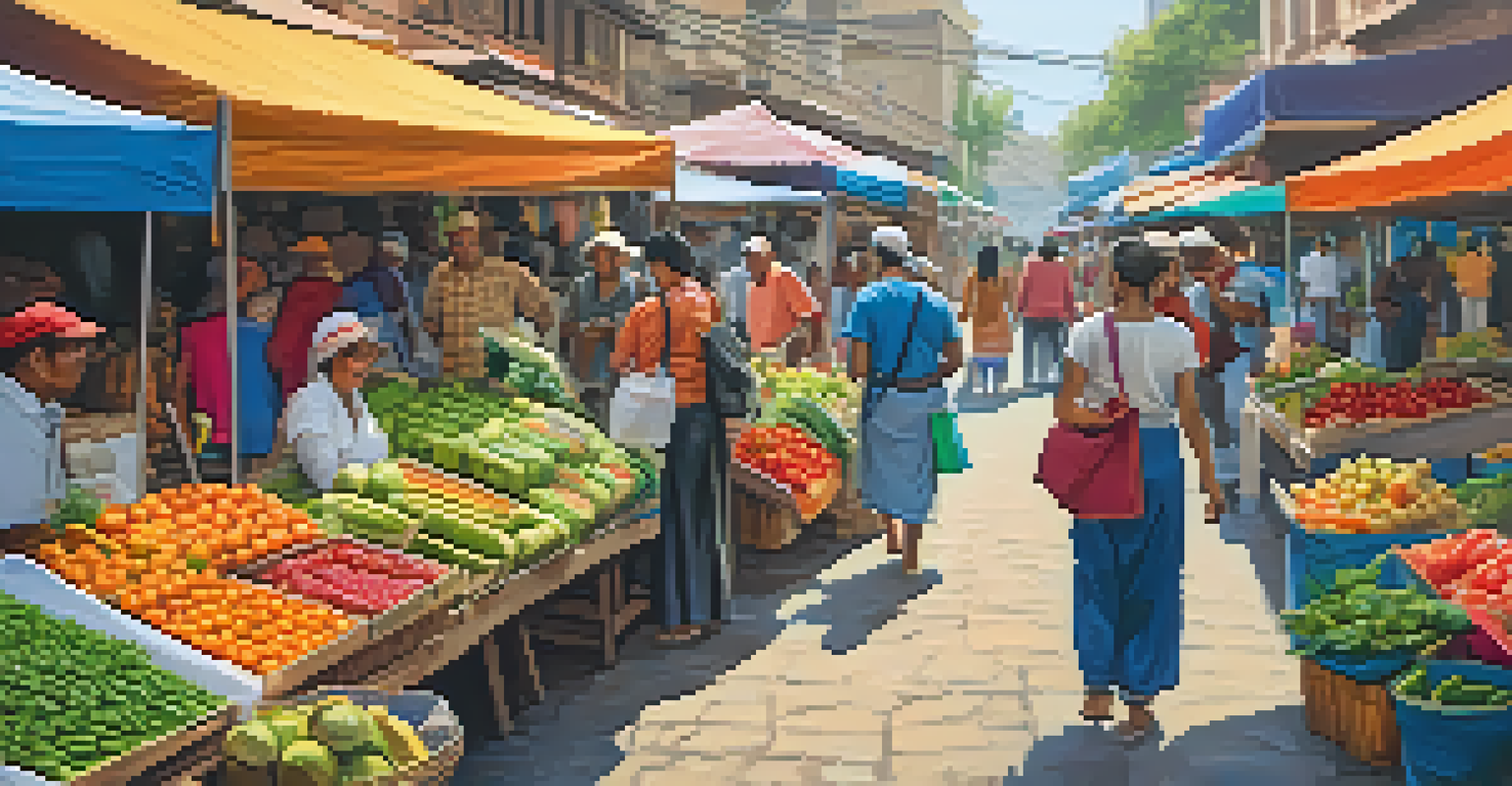Sustainable Travel Photography: Capturing Nature Ethically

Understanding Sustainable Travel Photography
Sustainable travel photography goes beyond just taking beautiful pictures; it's about respecting the environment and the cultures we encounter. This practice emphasizes capturing images in a way that minimizes our impact on nature and local communities. By being conscious of our actions, we can ensure that we leave a positive footprint while still enjoying the art of photography.
The greatest threat to our planet is the belief that someone else will save it.
Imagine walking through a breathtaking forest, camera in hand, but instead of trampling on delicate plants to get that perfect shot, you pause and find a vantage point that honors the ecosystem. This mindfulness not only protects nature but also enhances your creativity. When we prioritize sustainability, our photography becomes a reflection of our commitment to preserving the beauty we seek to capture.
Ultimately, sustainable travel photography is about storytelling—sharing the beauty of our planet while advocating for its protection. By adopting ethical practices, we can inspire others to appreciate and care for the natural world. Let's explore how to capture stunning images while respecting our surroundings.
Choosing Destinations Mindfully
When selecting travel destinations for photography, consider places that prioritize sustainability and conservation. Look for eco-friendly locations that are committed to preserving their natural beauty and cultural heritage. Researching these destinations can lead to enriching experiences that align with your values as a photographer.

For instance, visiting a national park that implements strict visitor guidelines can offer both stunning landscapes and a chance to practice responsible photography. These parks often have designated paths and viewing areas to minimize environmental impact, allowing you to capture the essence of nature without causing harm. Plus, you'll often find knowledgeable rangers who can provide insights into the local ecosystem.
Embrace Sustainable Practices
Sustainable travel photography prioritizes minimizing environmental impact while capturing the beauty of nature.
By choosing mindful destinations, you not only enhance your photography portfolio but also support communities and conservation efforts. This conscious decision-making can have a ripple effect, encouraging others to adopt similar sustainable practices in their travels.
Respecting Local Cultures and Traditions
Capturing the beauty of a destination often involves photographing its people and their cultures. It's crucial to approach this with respect and sensitivity. Always seek permission before photographing individuals or private spaces, and be aware of cultural norms that might affect your ability to capture certain moments.
We won't have a society if we destroy the environment.
Imagine traveling to a vibrant market bustling with life and color; instead of snapping pictures without consent, take the time to engage with the locals. This approach not only fosters positive interactions but can also lead to more authentic and meaningful photographs. When people feel respected, they’re often more willing to share their stories and allow you to capture their essence.
By honoring local customs and traditions, you enrich your travel experience and create a deeper connection with the places you visit. This respect shines through in your photography, showcasing the beauty of each culture while promoting ethical storytelling.
Using Eco-Friendly Photography Gear
As a travel photographer, the gear you choose can have an environmental impact. Opting for eco-friendly photography equipment is a great way to align your passion with sustainable practices. Look for brands that prioritize sustainable materials and ethical manufacturing processes in their products.
For example, consider using lightweight, durable camera bags made from recycled materials. Not only do they minimize your carbon footprint, but they also make it easier to carry your gear on long hikes. Additionally, investing in energy-efficient equipment can help reduce your overall energy consumption while on the road.
Respect Cultures and Traditions
Engaging with local communities and obtaining permission before photographing individuals fosters respect and authenticity.
Ultimately, the gear you choose can reflect your commitment to sustainability. By making mindful choices, you can contribute to a healthier planet while still capturing breathtaking images.
Practicing Leave No Trace Principles
The Leave No Trace principles are essential guidelines for anyone looking to enjoy and photograph nature responsibly. These principles encourage outdoor enthusiasts to minimize their impact on the environment by respecting wildlife, staying on trails, and packing out all waste. By following these practices, you can contribute to the preservation of the landscapes you love to photograph.
Imagine hiking to a stunning viewpoint for the perfect shot, only to find litter left behind by others. By adhering to Leave No Trace principles, you not only protect these beautiful areas but also set an example for fellow travelers. Carry a trash bag with you to pick up any litter you encounter, and encourage others to do the same.
By implementing these principles in your photography adventures, you ensure that future generations can enjoy the same breathtaking views. Your commitment to preserving nature will not only enhance your photography but also create a positive impact on the environment.
Capturing Wildlife Responsibly
Wildlife photography can be incredibly rewarding, but it comes with the responsibility to protect animals and their habitats. When photographing wildlife, maintain a safe distance and avoid disturbing their natural behaviors. This respect for wildlife ensures that your photography does not negatively impact their well-being.
For instance, using a telephoto lens can help you capture stunning close-up shots from a distance, allowing you to observe animals in their natural habitat without intruding. Additionally, familiarize yourself with local wildlife guidelines and regulations to ensure your actions align with conservation efforts.
Use Eco-Friendly Gear
Choosing environmentally responsible photography equipment helps align your passion for photography with sustainable practices.
By prioritizing ethical wildlife photography, you not only get the chance to create breathtaking images but also contribute to the protection of species and their ecosystems. Your photographs can serve as powerful advocacy tools, raising awareness about the importance of wildlife conservation.
Sharing Your Work Ethically
Once you've captured stunning images, sharing your work ethically is just as important as how you took the photographs. When posting on social media or in publications, provide context about your experiences and the sustainable practices you followed. This transparency fosters a deeper understanding of the importance of responsible travel photography.
Consider writing captions that highlight the significance of conservation efforts in the areas you've photographed. By doing so, you encourage your audience to appreciate not only the beauty of your images but also the story behind them. This approach can inspire others to adopt sustainable practices when they travel.

Sharing your work ethically not only enhances your credibility as a photographer but also amplifies the message of sustainability. Your platform can influence others to appreciate and protect the natural world, making a lasting impact through your art.
Inspiring Others Through Your Photography
Your photography has the power to inspire others to engage with and protect the environment. By showcasing the beauty of nature and the importance of sustainability, you can motivate your audience to appreciate and care for the planet. This impact can often extend beyond just your immediate circle to a broader audience.
For example, sharing your sustainable travel experiences in a blog or through social media can spark conversations about conservation and responsible travel. Engaging with your audience by sharing tips and stories not only builds a community but also encourages others to follow in your footsteps.
Ultimately, the art of photography can be a powerful tool for change. By using your platform to highlight the importance of sustainability, you can inspire future generations to appreciate the beauty of our planet and work towards its preservation.